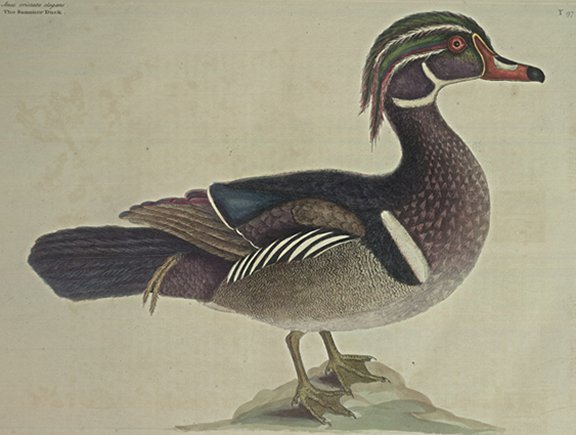Plate Number: I 97Anas Americanus cristatus elegans: The Summer Duck This is of a mean Size, between the common Wild Duck and Teal. The Bill is red, with a black Spot on the middle of it, and a black Nail or horny substance on the End, the Basis of the Bill is edged about with a yellow fleshy protuberance, pointing on each Side towards the Eyes, the Irides of which are very large and red, encompassed with a red Circle. The Crown of the Head is elegantly covered with a double Plume of long Feathers composed of blew, green and purple Colours, hanging down separately behind its Head, and divided by a narrow white Line, extending from the upper part of the Basis of the Bill backward: the lower Plume is likewise bordered with a white Line, beginning at the Eyes and running parrallel with the other, dividing the Plume from the under part of the Head, which is purple. The Throat is white, from each Side whereof proceed two white lines, one branching up towards the Crown of the Head, and the other below it, crossing the Neck. The Breast is of a muddy red, sprinkled thick over with white Spots, like Ermin. A little above the Shoulder is a broad white line, extended transversly, below which, and joining to it, runs a broad black Lift. The Back and upper parts of the Wings are variously and changeably coloured with brown, blue, and purple. The small Feathers near the Vent, are of a reddish purple, from amongst which spring two small yellow Feathers. The Tail is blue and purple. The lower part or verge of the Wings are lapped over and covered by the small downy side Feathers, extending from the Shoulders halfway the Wings, displaying alternately and in a wonderful manner black and white pointed Lines, varying in Appearance according to the Motion of the Bird, and different Position it puts its Feathers into, which adds much to the Beauty of it. The Sides of the Body below the Wings are brown, with transverse waved Lines, as in many of the Duck kind; the Legs and Feet of a reddish brown. They breed in Virginia and Carolina, and make their Nests in the Holes of tall Trees (made by Wood-peckers) growing in Water, particularly Cypress Trees. While they are young and unable to fly, the Old ones carry them on their Backs from their Nests into the Water; and at the Approach of Danger, they fix with their Bills on the Backs of the Old ones, which fly away with them. The Female is all over brown. |